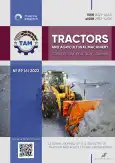The method of reasonable selection of a pneumatic tire set for an agricultural tractor
- Authors: Anisimov N.L.1,2
-
Affiliations:
- Petersburg Tractor Plant
- Peter the Great St. Petersburg Polytechnic University
- Issue: Vol 89, No 6 (2022)
- Pages: 421-429
- Section: Quality, reliability
- URL: https://journal-vniispk.ru/0321-4443/article/view/125949
- DOI: https://doi.org/10.17816/0321-4443-109895
- ID: 125949
Cite item
Full Text
Abstract
BACKGROUND: The method of reasonable selection of an agricultural tractor tire set is a tool to compare and choose a tire set with the best properties, to analyze the features of tire-soil interaction, to evaluate the feasibility of installing the proposed tire set and to identify ways of tractor design improvement. The relevance of tire set optimal selection for vehicles operating in agriculture is related to the soil compaction by chassis that lead to a change of its structure and agricultural yield reduction. In addition, it is related to low traction properties which increases fuel consumption, reduces performance and accelerate tire wear during operation on soft soils with wheel slip.
AIMS: The aim of the study is to increase the operation efficiency of an agriculture tractor as part of a machine-tractor unit with the pneumatic tire set selected with the developed method. The research subject is the influence of tire design properties on the tractor operational indicators.
METHODS: The article presents the method that allows to choose pneumatic tires from a wide range of different models and manufactures according to known and available technical properties for a newly-developed or modified agricultural tractor. A specific feature of method is determination of a generalized parameter of tractor operation and using it for comparison of different tires instead of using individual indicators. Driving wheels pneumatic tires of different sizes and properties for a four-wheel drive general purpose tractor are used in calculation. The method includes analytical determination of agrotechnical, technical, technical-and-economic operational indicators of tractor as well as economic components such as: maximum pressure on soil; a transverse static stability angle of a tractor, a slipping ratio, tire set cost. According to the calculated indicators and tire set cost, a generalized parameter is determined with the Harrington method and used for selection of pneumatic tire set.
RESULTS: As a result of the method application, tire sets for the K-7M “Kirovets” agricultural tractor were determined such as: the 710/70R42 tires regarding the main operational indicators of the tractor and the 710/70R38 tires regarding the main operational indicators of the tractor and tire set cost.
CONCLUSIONS: The given method can be proposed to tractor manufactures for tire set selection, chassis evaluation and identification of ways of design improvement.
Full Text
##article.viewOnOriginalSite##About the authors
Nikolay L. Anisimov
Petersburg Tractor Plant; Peter the Great St. Petersburg Polytechnic University
Author for correspondence.
Email: anisimovnl05@mail.ru
ORCID iD: 0000-0003-1270-1093
SPIN-code: 4958-4651
Postgraduate student, Leading Design Engineer
Russian Federation, Saint Petersburg; Saint PetersburgReferences
- Kutkov GM. Tractors and automobiles: Theory and technological properties. Moscow: KolosS; 2004. 504 p. (In Russ).
- Sharipov VM. Construction and dismemberment tractor. 2nd revised and updated. Moscow: Mashinostroenie; 2009. 751 р. (In Russ).
- Kotiev GO, Sharipov VM, Shchetinin YuS, Hashem MSh. Selection of low-pressure tires for agricultural tractors and all-terrain vehicles. Modern trends in the development of science and technology. 2016;(7–2):46–51. (In Russ).
- Guskov VV. Optimal parameters of agricultural tractors: Selection and justification of some parameters. Moscow: Mashinostroenie; 1966. 195 p. (In Russ).
- Ageikin YaS. All-terrain wheeled and combined propellers: Theory and calculation. Moscow: Mashinostroenie; 1972. 184 p. (In Russ).
- Li H, Schindler C. Analysis of soil compaction and tire mobility with finite element method. In: Proceedings of the Institution of Mechanical Engineers, Part K. Journal of Multi-body Dynamics. 2013;227(3):275–291. doi: 10.1177/1464419313486627
- Andrianov AV. Improving the technical and economic indicators of a wheeled tractor by improving the propulsion when performing spring field work (using the example of HTZ-150K-09) [dissertation abstract]. Chelyabinsk; 2015. 24 p. (In Russ).
- GOST 12.2.019-2015. Interstate standard. Occupational safety standards system. Agricultural tractors and self-propelled machines. General safety requirements. (In Russ). Available from: https://docs.cntd.ru/document/1200137155. Accessed: 15.12.2022.
- Guskov VV, Velev NN, Atamanov YuE, et al. Tractors: theory. Ed. by V.V. Guskov. Moscow: Mashinostroenie; 1988. 376 p. (In Russ).
- Saarilahti M. Soil interaction model. Appendix report No 7. 3: Tyre/soil models for predicting rut formationand soil compaction. University of Helsinki, Department of Forest Resource Management; 2002. 15 p.
- GOST R 58655-2019. National Standard of the Russian Federation. Agricultural mobile machinery. Rates of force produced by propelling agents on soil. (In Russ). Available from: https://docs.cntd.ru/document/1200169432. Accessed: 15.12.2022.
- GOST 27021-86. The state standard of the USSR. Agricultural and forestry tractors. Towing classes. (In Russ). Available from: https://docs.cntd.ru/document/1200009845. Accessed: 15.12.2022.
- Gorodetsky KI, Parfenov AP, Lavlinsky AM. Generalized traction indicators of agricultural tractors. Tractors and agricultural machinery. 2017;(2):3–8. (In Russ).
- Guskov AV. Determination of traction-coupling qualities of tires of tractor driving wheels. Bulletin of Kharkiv National Automobile and Road University. 2007;(37):71–74. (In Russ).
- UPTIRE.ru [Internet]. Tires, wheels and a camera for agricultural machinery. (In Russ). Available from: http://uptire.ru/. Accessed: 15.12.2022.
- Adler YuA, Markova EV, Granovsky YuV. Experiment planning in the search for optimal conditions. 2nd ed., revised and updated. Moscow: Nauka; 1976. 279 p. (In Russ).









